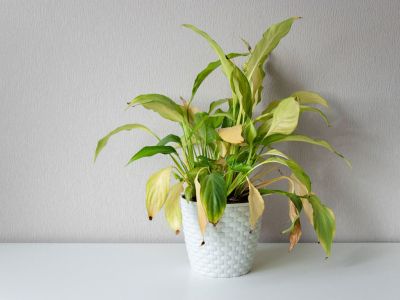What is Root Rot?
Root rot can have two sources — one is prolonged exposure to overwatered conditions that can cause some of the roots to die back due to a lack of oxygen. As they die, they can start to decay or rot away. The rot can then spread to healthier roots and kill them as well, even if the soil conditions are corrected. The other source can be a fungus in the soil. The fungus may lie dormant in the soil indefinitely and then suddenly flourish when the plant is overwatered once or twice. The root rot fungus attacks the roots and causes them to die and rot away.
What Does Root Rot Look Like?
If you are unsure whether your plant has root rot, you may be wondering, “What does root rot look like?”. If the plant is slowly wilting and the leaves are turning yellow for seemingly unknown reasons, you will want to check the roots. Remove the plant from the soil and feel the roots. The roots affected by root rot will look black and will feel mushy. Affected roots may literally fall off the plant when you touch them. Healthy roots may be black or pale, but they will feel firm and pliable.
Treating Root Rot
Whether the problem is prolonged overwatering or a single overwatering that caused a root rot fungus flare-up, you must act quickly. Treating root rot ASAP will give your plant the best chance to survive. Start to treat root rot by removing the plant from the soil and washing the roots under running water. Wash away as much soil and affected roots as possible while being gentle with the plant. Next use a sharp, clean pair of shears or scissors to trim away all of the remaining affected roots. When you treat root rot, you may have to remove a significant amount of the root system if the plant is badly affected. If this is the case, clean the shears or scissors with rubbing alcohol and prune back one-third to one-half of the leaves on the plant. This will give the plant a better chance to regrow the roots, as it will not need to support as many leaves. Continue treating root rot by disposing of the soil in the pot that the plant was in. Wash the pot thoroughly with a bleach solution. If possible, dip the remaining healthy roots in a fungicide solution to kill off any possible root rot fungus. After treating root rot in the plant, repot the plant in a clean potting mix. Make sure the container has good drainage and only water the plant when the top of the soil is dry. While regrowing its roots, do not fertilize the plant, as this may stress it. You do not want to have to treat root rot again in the plant. Hopefully, now the plant will recover and you will get your beautiful houseplant back.
